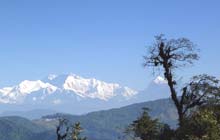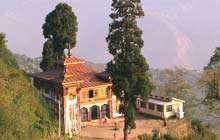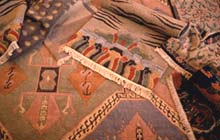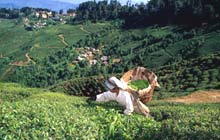|
|
 |
| Editor's Note |
Darjeeling |
|
|
 Aptly called Queen of Hill Stations, Darjeeling still resembles an old Victorian town, complete with cobbled roads, old-world bungalows and endless tea estates. Who would have imagined that what appeared as an impenetrable forest and mountainside to the two British agents who were sent to explore the area, would one day be the stunning Darjeeling that draws hordes of tourists with its stunning views of the Kanchenjunga, oak, pine and orchids! And, as a trekker's paradise, it is witness to thousands of people who enjoy its adventure challenges. This is just the place where you wouldn't mind doing nothing; just soak in the cool climate and sip your morning cuppa before the golden rays of the sun! Yes, it's crowded now at all seasons and frequent landslides play havoc to its connection with the rest of the country. But 'Dorje Ling' or Place of the Thunderbolt continues to be its alluring-best with its villages, waterfalls and the tiny toy-train! Aptly called Queen of Hill Stations, Darjeeling still resembles an old Victorian town, complete with cobbled roads, old-world bungalows and endless tea estates. Who would have imagined that what appeared as an impenetrable forest and mountainside to the two British agents who were sent to explore the area, would one day be the stunning Darjeeling that draws hordes of tourists with its stunning views of the Kanchenjunga, oak, pine and orchids! And, as a trekker's paradise, it is witness to thousands of people who enjoy its adventure challenges. This is just the place where you wouldn't mind doing nothing; just soak in the cool climate and sip your morning cuppa before the golden rays of the sun! Yes, it's crowded now at all seasons and frequent landslides play havoc to its connection with the rest of the country. But 'Dorje Ling' or Place of the Thunderbolt continues to be its alluring-best with its villages, waterfalls and the tiny toy-train! |
|
| Climate |
 |
Summer
May-June, Mild & temperate
Temperatures - 8.59ÂșC-14.89ÂșC |
|
 |
Monsoons
June-September, Extremely heavy rainfalls, mist and fog
Annual rainfall - 320 cms |
|
 |
Winter
December-February, Freezing cold mists and fog
Temperatures - 1.5ÂșC -6.11ÂșC |
|
| Local Languages: |
Nepali (Gorkhali), Hindi, Bengali & English |
| Best Time to Visit: |
March-May and September-November. We recommend avoiding the monsoons due to the frequent landslides that often cut off Darjeeling from other cities and disrupt airport and land services. |
| Clothing: |
Light woolens & cotton during summers & heavy woolen during winters. Carry your best raingear if traveling during monsoons. Heavy boots and raincoat are a must. |
| Moving Around: |
This picturesque town is best explored on foot. Bicycles, two-wheelers and taxis are also available for excursions. Private vehicles are also available for sightseeing at fixed rates and may be reserved through Tourist Bureau, Govt. of West Bengal, and Darjeeling. |
| Tourist Offices |
Darjeeling Gorkha Hill Council
Silver Fir Building, The Mall
Darjeeling
Tel: 0354-2254214
West Bengal Tourism Dev. Corp.
1 Nehru Road
Kolkata
Tel: 033-2254050 |
|

The Mall: Essentially a market place, it is one of the most defining areas of this town. The Mall is the center of the town and is lined on both sides with shops that sell Tibetan hand-knitted sweaters and souvenirs, curios, Himalayan artifacts and antiques. This hive of all activities leads to the Chowrastra or town square, where you can hire ponies for trotting around or simply catch views of the Kanchanjunga Range.
Â
Observatory Hill: This is the oldest site in Darjeeling where most of the high end hotels are located. Legends have it that a Red Hat Buddhist Monastery called Dorje Ling, or 'Place of the Thunderbolt', from where Darjeeling derives its name, stood at this spot, which was later destroyed by the Nepalis. The famous Bhutia Basti Gompa was located here before being shifted near Chowrasta. Today, a Kali Temple sacred to both Buddhists and Hindus is located here.
Himalayan Mountaineering Institute: This Institute was founded and managed by the late Tenzing Norgay who conquered Mt Everest with Sir Edmund Hillary in 1953. Today, it has on display records of some major expeditions undertaken. Next to this is the Everest Museum, which traces the history of different attempts on the world's highest peak. You may also contact the institute for mountaineering courses for all levels. And a one-off rock-climbing session can be taken at the Tenzing Norgay Rock, located on the northern fringes of Darjeeling.
Open from 9 am-4.30 pm
Entrance fee: Rs 6
Darjeeling Rangeet Valley Passenger Ropeway: Located at North Point about 3-km from the town, this is the first passenger ropeway in India. Temporarily under restoration, it connects North Point to Singla Bazaar over the Rangeet River in the valley.
Open from 8 am-3:30 pm
Ghoom Monastery: One of the renowned monasteries of Darjeeling, Ghoom is located at 8000 ft, 8 kms from Darjeeling and belongs to the Yellow sect of Buddhists. It is home to the 15 ft high statue of the Maitreya Buddha. Painted in gold, the statue is said to be coated with precious stones. The rooftops and facades have colorfully painted figures intended to scare away evil spirits. The external walls are lined with prayer wheels, which are spun during praying and the internal walls are lit with butter lamps. Also check out the several thangkas on the walls. The monastery also houses the Tibetan translations of some of the most famous Sanskrit works by literary geniuses.
Bhutia Basti Gompa: Situated 1 km out of town, this monastery is built against the spectacular backdrop of the Kanchenjunga Mountains. The shrine located here, earlier stood on the Observatory Hill. It is built in Tibeto-Nepalese architecture and is a storehouse of ancient Buddhist texts and artifacts, including the original volume of the Tibetan Book of the Dead.
Tiger Hill: This is the highest point in the area and is located about 14 kms from Darjeeling. The best time to visit it is early morning, when the first rays of the sun create a dramatic effect on the distant Himalayan peaks. And if you're lucky you just might also catch a glimpse of Mount Everest. Carry your camera and some warm clothing, since the altitude makes it bone-jarringly cold.
Darjeeling Toy Train: Built in the late 19th century, the Darjeeling Himalayan Railway is today a World Heritage sight, only the second railway to have made it to that list. Built through a zigzag of tracks, the distance of almost 87 kms between Kurseong and Ghoom takes almost the entire day. And it's worth it! En route, you pass through rhododendron slopes, rolling hills and spectacular views of the Kanchenjunga, and cross villages with quaint names like Margaret's Hope, and chug past the front doors of houses that have red-tiles and potted-flowers.
Gardens: As picturesque as Darjeeling is, head out to the numerous gardens and parks. Head out to the Shrubbery, behind Raj Bhavan, and the Lloyd Botanical Gardens that offers several varieties of flowers and orchids. Also you can catch a view of the Kanchenjunga Range and Singalila Valley. The Bengal Natural History Museum is excellent for garnering information on the varied Himalayan fauna and Bengal wildlife.
Open from 10am-4pm
Entry fee: Rs 2
Padmaja Naidu Zoological Park: Other than the usual animals here, this zoological park is home to the Snow Leopard Breeding Center, the only place in the world where breeding of snow leopards in captivity has been successful. Led by Kiran Moktan, who dedicated his life to this program, catching a glimpse of the adorable cubs gamboling with their mother, is an ultimate experience. Remember to maintain silence when visiting the enclosure. While walking out, keep an eye on the trees nearby to sight the elusive red panda!
Open from 10am-4:30pm
Entry fee: Rs 10 |
|
 If you are the non-veg foodie, the best option for breakfast and snacks is Keventer's. It has its own piggery, so the pork products including cheese, bacon, pork and ham are the must-haves here. Sweet-lovers should not miss out on Glenary's for its most sinful chocolate rolls, pastries cinnamon buns, croissants, quiches and jam tarts - all home-made! SuperSoft Ice-Cream Parlour has the creamiest handmade ice-creams and light snacks. Or walk down to Stardust, which serves the best hot chocolate in the world and an amazing vegetable stew. Also, check out the food stalls at the Lower Bazaar, which sell everything from chowmein to momos. Dekevas has the most amazing offering of thukpa, momos and the most heavenly chilli chutney! For vegetarians, the best option would be at Jain Jaika Restaurant at Laden La Road or at Darjeeling Planter's Club. You can also dine at some of the hotels, even if you aren't staying there. Just remember to make a prior reservation. For some of the most heavenly tea, head out Nathumulls at Laden La Road, which has all possible varieties. If you are the non-veg foodie, the best option for breakfast and snacks is Keventer's. It has its own piggery, so the pork products including cheese, bacon, pork and ham are the must-haves here. Sweet-lovers should not miss out on Glenary's for its most sinful chocolate rolls, pastries cinnamon buns, croissants, quiches and jam tarts - all home-made! SuperSoft Ice-Cream Parlour has the creamiest handmade ice-creams and light snacks. Or walk down to Stardust, which serves the best hot chocolate in the world and an amazing vegetable stew. Also, check out the food stalls at the Lower Bazaar, which sell everything from chowmein to momos. Dekevas has the most amazing offering of thukpa, momos and the most heavenly chilli chutney! For vegetarians, the best option would be at Jain Jaika Restaurant at Laden La Road or at Darjeeling Planter's Club. You can also dine at some of the hotels, even if you aren't staying there. Just remember to make a prior reservation. For some of the most heavenly tea, head out Nathumulls at Laden La Road, which has all possible varieties. |
|
 It's tea, no doubt! Pick up some of the most exotic varieties from Nathumull Tea Merchants on Laden La Road. First Flush and Golden-Tipped Orange Pekoe are some of the best varieties to get. And if it's curios and trendy souvenirs you're looking for, rummage through brass statuettes, tinkling wind chimes, leather artifacts, Himalayan handicrafts and silver jewellery in the shops that line the Chowrasta and Mall. The Tibetan Refugee Centre also offers options to pick up Tibetan wool, silk, thangkas and bronze, copper, silver and gold artifacts. You can also get reasonably priced Tibetan Carpets at Hayden Hall and Third Eye. It's tea, no doubt! Pick up some of the most exotic varieties from Nathumull Tea Merchants on Laden La Road. First Flush and Golden-Tipped Orange Pekoe are some of the best varieties to get. And if it's curios and trendy souvenirs you're looking for, rummage through brass statuettes, tinkling wind chimes, leather artifacts, Himalayan handicrafts and silver jewellery in the shops that line the Chowrasta and Mall. The Tibetan Refugee Centre also offers options to pick up Tibetan wool, silk, thangkas and bronze, copper, silver and gold artifacts. You can also get reasonably priced Tibetan Carpets at Hayden Hall and Third Eye. |
|
One of the first celebrations of the New Year, Maghe Sankrati celebrations are marked by great celebrations. This is the time when the locals get together to eat various edible species of Dioscorea, known collectively as yam. Losar Festival is celebrated in February as the Tibetan New Year. The youth visit the streets dressed in multi-hued streets, performing the traditional Yak dance. The festival lasts for a week and the singing and dancing continues with the youth shouting out greetings of Tashi Delek (auspicious) to herald the New Year. Darjeeling at this time of the year gets that special touch of elegance with the streets decorated with all sorts of colourful streamers.
Buddha Jayanti or the birth anniversary of Lord Buddha in April witnesses a procession that starts from Buddhist monasteries with Tibetan Monks followed by the idol of Lord Buddha's. The monks also carry Buddhist holy books in the procession. Saga Dawa (Thrice Blessed Day) is celebrated in May. It is believed that Buddha's soul entered his mother's womb, and as an adult he attained enlightenment and passed onto nirvana on this day. You can witness a special procession that takes place all day on the streets of Darjeeling, where monks and locals parade with religious banners, icons and holy books.
Kwati Purne held in the month of August witnesses the locals eat a special gruel made of sprouted legumes. Guru Purnima is a special day for Nepali Shamanism, when Jhankris (witch doctors) dance with their special dress and musical instruments to welcome the gods and goddesses on their return after the slumber in Sawan (the Nepali month). Naag Panchami in August is celebrated by the Nepali Hindus. During this, priests visit door to door with special prayers and paste the picture of snakes as Lord Bishnu for protecting the house.
Tihar (Teohar) is celebrated by the Nepali Hindus where the festival begins by giving crows good food as they are considered as the messenger of the Lord of Death, Yama. The festivities carry on for a week and are celebrated with great fervor and excitement along with lights and firecrackers that illuminate the evenings. Nambun in December is celebrated by the Lepchas tribe. On the new moon day they make a rice effigy of the demon, Lhaso Mung Punu and post a prayer take it away from the house. For the next 10-15 days, celebrations are marked by good food, new clothes and singing and dancing. Christmas on the 25th of December is celebrated all over with the festivities lasting for a week till New Year. |
|
|
|
| Air: |
 |
The nearest airport is at Bagdogra located 10 Kms from Siliguri. From Bagdogra, you can take a bus or hire a taxi to Darjeeling. Several flights regularly operate between Bagdogra and the major cities and metros of India. It takes about a couple of hours from the airport to reach the beautiful hill top at Darjeeling. |
|
|
|
| Rail: |
 |
For a thrilling session, you can take the famous toy train, actually a meter gauge train operating over some of the most beautiful sights. The nearest railhead is New Jalpaiguri Junction (75 km / 3 1/2 hrs) and Siliguri, both of these having direct railway connections with Kolkata, Delhi, Mumbai, Guwahati and other major cities of India. |
|
|
|
| Road: |
 |
You can take the Hill Cart Road from Siliguri, which is in a relatively good condition. Buses and local taxis leave Siliguri every 30 minutes and the drive from the plains to the mountains and fields is definitely a treat. You can hire private vehicles and there are also public buses and taxis from Mirik, Gangtok, and Sikkim. |
|
|
|
|
 As much for its natural beauty, Darjeeling is just as famous for its chai industry. In fact, a trip to Darjeeling definitely is incomplete without a walk through its lush tea gardens. Sprawling estates (over 85) dot the entire landscape, which produce different varieties of tea, collectively called Darjeeling Tea. Some of these tea gardens are also open to visitors and you can watch tea-pickers at work and probably get lesson or two in tea-plucking! Some of the most famous estates are Badamtam, which also has a 14-ft bronze statue of the Buddha, Runglee Rungliot, Happy Valley, Thurbo, Lopchu, Snowview, Margaret's Hope, Teesta Valley and Castleton. While Darjeeling yields a large variety of green tea, the delicate black tea produced here is considered to be one of the finest in the world. As much for its natural beauty, Darjeeling is just as famous for its chai industry. In fact, a trip to Darjeeling definitely is incomplete without a walk through its lush tea gardens. Sprawling estates (over 85) dot the entire landscape, which produce different varieties of tea, collectively called Darjeeling Tea. Some of these tea gardens are also open to visitors and you can watch tea-pickers at work and probably get lesson or two in tea-plucking! Some of the most famous estates are Badamtam, which also has a 14-ft bronze statue of the Buddha, Runglee Rungliot, Happy Valley, Thurbo, Lopchu, Snowview, Margaret's Hope, Teesta Valley and Castleton. While Darjeeling yields a large variety of green tea, the delicate black tea produced here is considered to be one of the finest in the world. |
|
|
|
|
|
|
|
 |
|
|
|